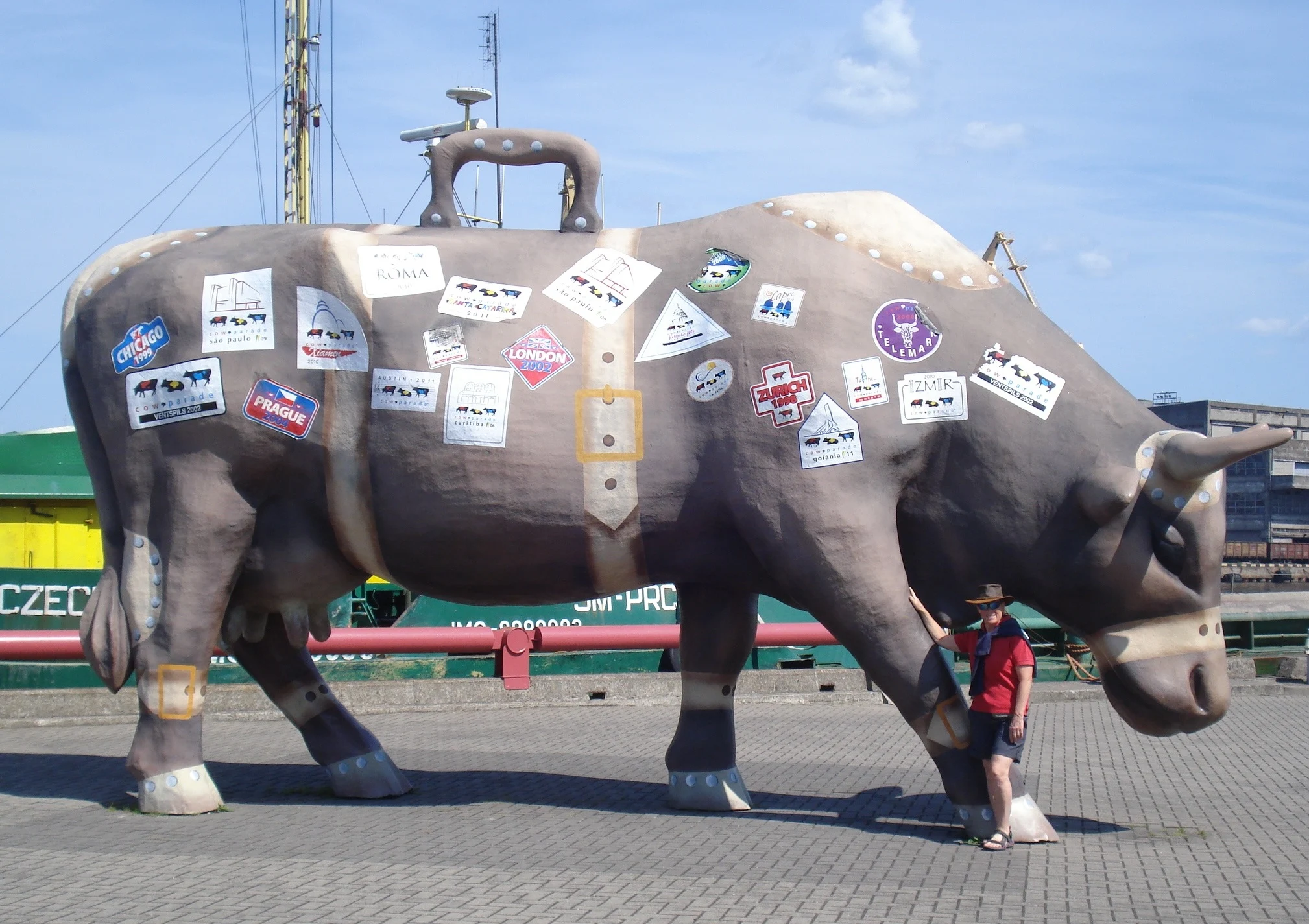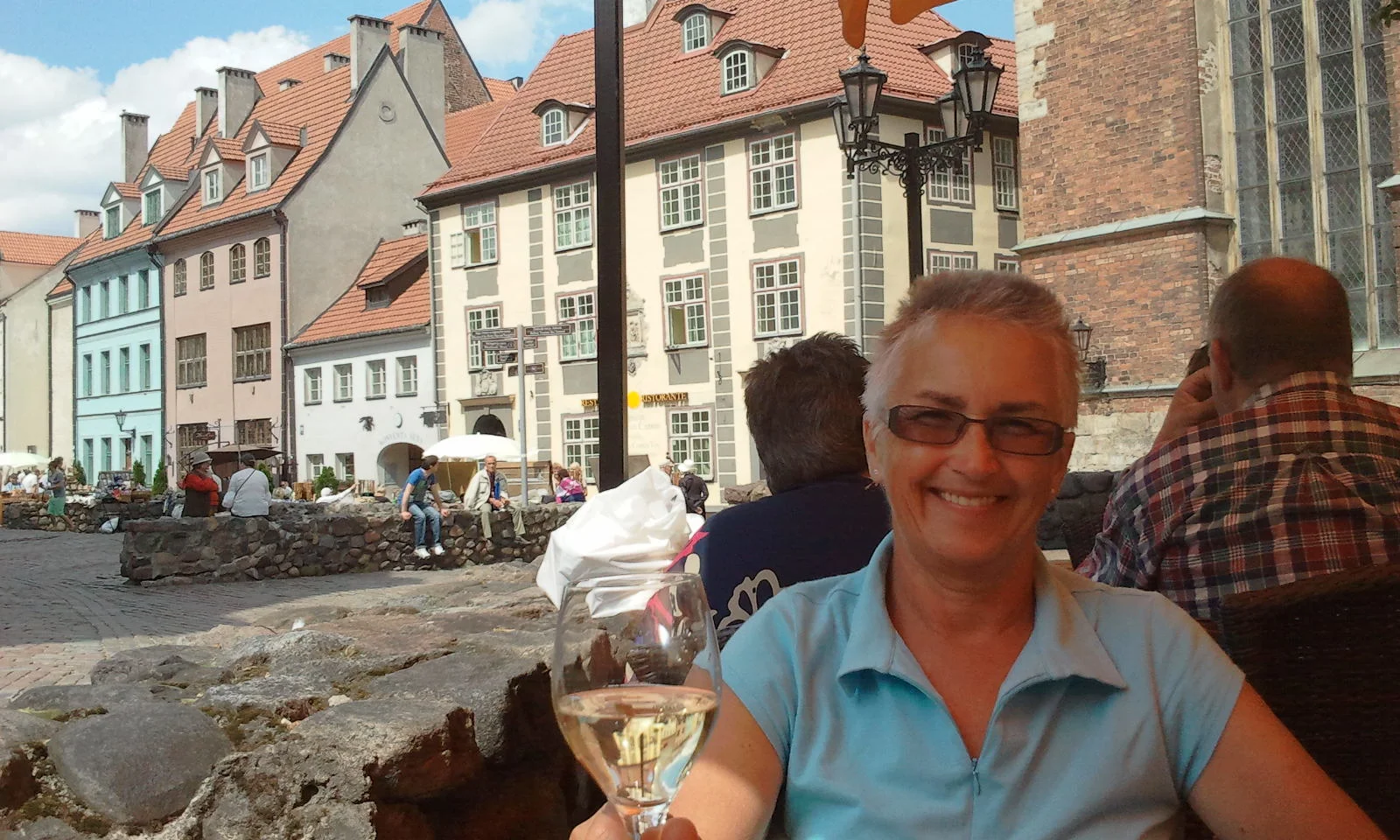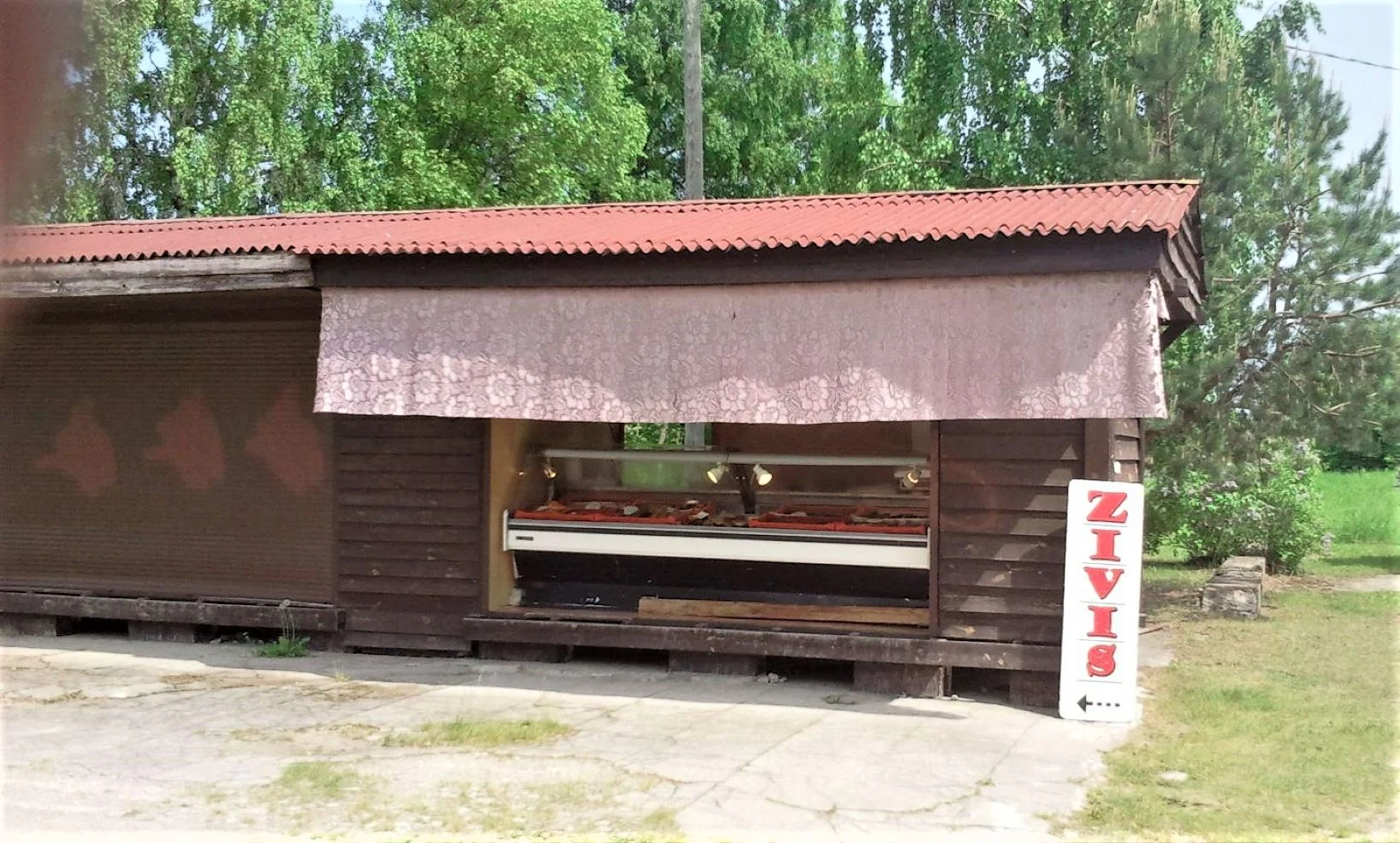We are driving around north-eastern Europe for 6 months in Vanni our motorhome, and have just spent several days in remarkable Rīga. We have been waiting for a visa to get Vanni into Russia and while waiting, drove along the west coast of the Gulf of Rīga, where we saw many beaches, fishing villages, and interesting towns.
 |
| Marg at the beach at Jūrmala, Latvia |
Just west of Rīga, we paid a small fee to enter a national park and get into Jūrmala, the largest seaside resort in the Baltic States. But then we found a walkway to a very lovely and quiet beach, and enjoyed a walk along the shoreline.
So far, seeing more of Latvia seemed like a good use of our time so we kept driving, sticking to the coastal road.
After 20-minutes, we arrived in Lapmežciems, a fishing village of around 1,200 people sitting between the Gulf of Rīga and Lake Kaņieris. Lapmežciems is renowned for its smoked fish, so we took a break at a roadside stall there and bought some smoked herring, before driving on.
Our next stop was the village of Engure (pop around 1,500) located beside Lake Engure, an ancient sea lagoon and now a wetland. We stopped for a look around, then found a beach where we had our newly purchased smoked herring for lunch. It was delicious.
After lunch, we drove to Mērsrags, another small fishing village. Mērsrags has a large yachting port and a lovely sandy beach that we walked along. Nearby was Kaltene, an even smaller village. Kaltene is famous for its several kilometre-long stone beach which was windswept but beautifully haunting.
Our next stop was Roja which has an old port that was once used by ancient Vikings. After that, we drove to Cape Kolka (Kolkasrags), the point where the water of the Gulf of Rīga meets the Baltic Sea.
 |
| Marg at Cape Kolka, Latvia |
Arriving at Cape Kolka, we stopped to admire the lovely beach, which has very fine yellow sand. It was deserted with only a few windsurfers, and some colourful fishing boats.
Nearby, we found a camping ground and parked there for the night. It was a lovely place, fronting onto the beach with very few other campers. Unfortunately, the only power-points were close to the smelly long-drop toilets, and the showers only had cold water. So we went without power, and used Vanni’s shower and toilet.
The next morning, we turned south-west to drive along the Baltic Sea coast. Thirty minutes later, we stopped in Miķeļtornis to view its impressive lighthouse. Built in 1884, the lighthouse stands tall at 59 metres (193 ft), making it the highest in the Baltic States.
After paying 1 lat (about NZ $2) we climbed 265 steps to the top. It was very windy up there but the view was great, although the slope on the top outside balcony was downwards, and gave us a very uncomfortable feeling that high off the ground.
The 18th century church, the community house, and the lighthouse seemed to be the sights in this tiny hamlet (pop 30). Miķeļtornis is one of twelve Livonian villages along this Livonian Coast. Livonians are originally a Baltic-Finnish people indigenous to northern Latvia and parts of Estonia.
Leaving Miķeļtornis, we drove to Ventspils which is the third largest city in Latvia having a population of around 37,000.
 |
| Leigh with “The Travelling Cow” one of the many cow statues in Ventspils, Latvia |
It was an attractive drive into the city, showing lots of lovely gardens and floral art, and a most amazing collection of cow statues. The eclectic collection of cows was originally created for the world’s largest public art event held in Ventspils in 2012 - many of cows are still there.
But, while the town seemed to take a lot of pride in its gardens, sculptures, and public art, it appeared to be suffering economically, having dingy little shops with unfashionable clothes and appliances on sale.
Ventspils also has an Old Town with a small market square, lots of historic wooden buildings and little shops, but it seemed to be very quiet when we were there. We tried to find a nice café or restaurant for lunch but ended up at a Tex Mex restaurant where the food was ok, but not very traditional.
Later, we found a nearby camping ground and parked there for the night.
That evening, we explored the Open-Air Museum next to our camping ground. It was interesting, and contained an assortment of Latvian houses, windmills, and artefacts from the early 19th century onwards.
There was also a small and quaint steam train that did a tourist route around the park. It was an easy walk to the beach which had a boardwalk down onto the sand, and while there were quite a lot of people there, it didn’t seem crowded.
 |
| Marg in Kuldīga, Latvia |
The next day we drove to Kuldīga, considered to be the most beautiful example of a 16th-17th century town in Latvia. Many of the houses are wooden with attractive carvings and shuttered windows. It had a more vibrant feel to it than Ventspils, and we really enjoyed exploring it.
We had a nice lunch at a small and quaint café, then wandered around a bit more enjoying the narrow, cobbled streets and traffic-free main street, finding it a gorgeous little town. The Old Town is built around a wee river that runs through its centre, with the houses built right up to the water’s edge.
 |
| Leigh at Ventas Rumbas falls, Kuldīga, Latvia |
Following the river we discovered the Ventas Rumbas, a series of rapids that have shaped one of the widest waterfalls in Europe at 270 metres (885 feet). But while it was wide, it wasn’t very high.
Leaving Kuldīga, we decided that the western area we had explored was attractive, quiet, and undeveloped, and that with the lovely sandy beaches, gentle seas, and closeness to Rīga, it was an international destination waiting to be discovered.
As we had more days to fill while waiting for our documents for Vanni, we next drove up the coast east of Rīga. After a while, we followed a sign to what turned out to be a lovely beach at Saulkrasti. On the beach we found a sort of, scarecrow. However, no-one could tell us what it was for.
After enjoying a beach walk, we headed back toward the main road. But while driving down a narrow gravel road to get there, disaster struck!
 |
| Legs of our helper who moved the log wedged in Vanni’s bottom |
Driving, Marg tried to avoid a large pothole on her left, and instead hit a log of wood sticking out onto the road on her right. We heard a crunch then a bang! Next minute, we had a thick branch sticking out of Vanni. It had broken a side panel, and was firmly lodged underneath in Vanni’s metal chassis.
We couldn’t move the branch, but luckily a van driver arrived and he, and a man in an Audi going the other way, stopped to help us. They managed to move the branch to get us free, but it left a hole in Vanni’s side panel that flapped about as we drove.
Leigh managed to salvage a metal bracket and had some screws stashed away, and by the time she used those and some duct tape to secured it, Vanni was ok to drive. Two unhappy campers then headed back to the campsite in Rīga to get Vanni repaired.
At the campsite, a van parked beside us that was Czech registered like us. And like us, they were not Czech people, but from Malta. Then a delightful German woman came over as she was born in the Czech Republic, and was excited to see two Czech vans. We all we had a lovely evening chatting.
 |
| Marg dining out in Rīga, Latvia |
The next day, we visited Rīga’s old town again, and had a meal in a medieval restaurant. It was delicious - Leigh had a chop of red deer and Marg had grilled eel - both very tasty. It made us feel better about our misadventure.
Back at the camp later, the manager was very helpful in getting one of his workmen to find some right sized screws to replace Vanni’s duct tape. But the good news was that we found a garage that deals with our model of campervan, and the guy there booked us in to have Vanni repaired straight away.
However, the fates, not contented with stopping us at the Russian border then banging a hole in Vanni, decided that a flat tyre on Leigh’s bicycle would be in order!
So the next morning, after delivering Vanni to the garage, we also delivered Leigh’s bike to the local bike shop to fix a puncture.
 |
| Dried fish at the local market outside Rīga, Latvia |
After leaving the bike we were on foot and by chance, came upon a Saturday food and crafts market. We had a lovely time wandering around there, and bought some yummy food to take home.
By now, we were quite tired - trying to get legal documents from another country, and a motorhome and bike fixed in a foreign city with no knowledge of the local language or value of the local currency, sure is testing!
 |
| Marg at Rīga beach |
That afternoon, we went back and picked up the bike, and rode a circuitous route home to explore Rīga's attractive riverbank beach.
All this time, we had been anxiously waiting for news of Vanni’s Russian visa. Eventually, after tracking our package on DHL, we noted it had finally arrived in Rīga. Soon after, we spotted a DHL van pulling up at the campsite reception – yes – our papers – Yay!!! Within 30 minutes, we were on the road and headed swiftly out of Rīga toward the Russian border, hoping we would not be denied entry again. But you can read about it in the next blog.
This blog describes part of our 6-month motorhome trip around north-eastern Europe, which began in Prague.


.jpg)
-a.jpg)

a.jpg)


